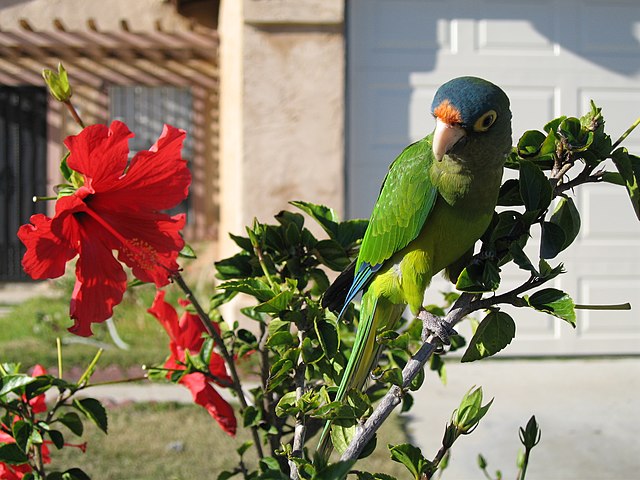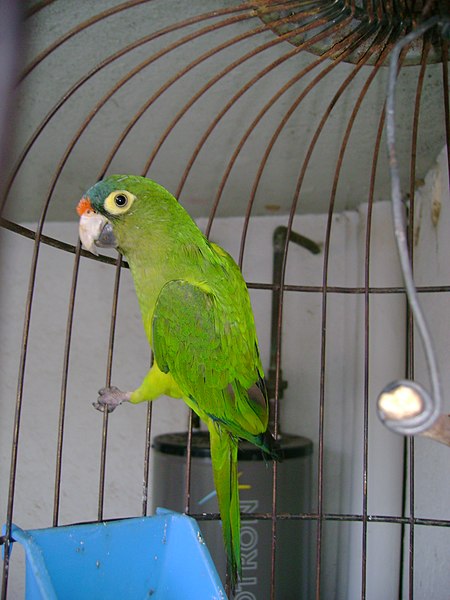The Half-Moon Conure (Aratinga canicularis), also known as the “Half-Moon Parakeet” or “Half-Moon Shaped Conure” is a medium-sized species of parrot that belongs to the genus Aratinga in the family Psittacidae. It is native to the tropical forests of South America, specifically the regions of Brazil, Colombia, Ecuador, French Guiana, Guyana, Peru, Suriname, and Venezuela.

In terms of physical characteristics, the Half-Moon Conure typically measures around 30cm in length and weighs between 120-135 grams. They have a relatively short tail, and their wings are relatively short and broad. They have a distinctive red patch on their forehead and a blue crescent-shaped patch on the crown, which can be used to distinguish them from other Aratinga species. Their beak is strong and curved, adapted for cracking seeds and nuts. The body plumage is primarily green, with blue-green on the head, red-orange on the shoulders, and a blue-green tail. The underwing coverts are yellow, and the flight feathers are blue-green.
In terms of behavior and ecology, Half-Moon Conures are social and gregarious birds, often found in flocks of up to 50 individuals. They are active and playful, known to engage in aerial acrobatics and foraging behaviors. They have a wide vocal range and are known for their loud calls and screeches. They feed on a variety of seeds, fruits, and nuts, and have been observed using tools to obtain food.
How to Stop Bad Behavior in Half-Moon Conures
Your cute little half-moon conure has become a big handful. He’s biting, screaming, and pushing you and your family around. I bet you didn’t expect this much attitude out of such a little bird! The truth is this little bird is a powerhouse of attitude and he may push your boundaries as far as he can.

If you’ve already allowed him to get away with being the boss of the home, it’s time to lay down the law – positively of course. Here’s how to nip your half-moon conure’s bad behavior in the bud.
- Give your half moon conure plenty of your time and attention every day.
They enjoy interacting with people, so when possible let him out of his cage to hang out with you and your family. Your Conure also enjoys being handled. If biting is a real problem consider placing a towel on your hands when you get him out of the cage, at least until he is properly trained. Of course, when you’re unable to be with your half-moon, make sure that he has plenty of room to fly around his cage and plenty of toys to keep him busy.
- Don’t accidentally encourage bad behaviors with your half-moon conure.
Many birds go through a nipping phase and if you punish it or have an extreme reaction, you can actually train them to continue nipping. Similar habits can be developed if you have a strong reaction to any adverse behavior whether it’s biting, screaming, charging, or feather plucking.
If you yell or splash your bird for screaming or biting, you teach him to be fearful of you. Fear breeds bad behavior, you’re doing exactly the opposite of what you want to do. You want your bird to love and trust you. You want your Half Moon Conure to feel comfortable, happy, and well-socialized.
- Trick-train your half-moon conure.
Trick training solves bad behavior problems in several ways. First and foremost it gives your Half Moon Conure what he wants most; attentive and structured time with you. Secondly, it engages your Half Moon Conure’s intelligence. Bored conures can cause trouble. Trick-train your Half Moon Conure and you challenge his intelligence. You stimulate his problem-solving skills. Third, when you trick train, you build a bond of trust between you and your bird.
Lastly, though not the least important, is that there are specific tricks that you can train your bird to make it stop those annoying behaviors. Biting when you retrieve him from the cage for example can be trained away by training the step-up and step-down commands.
